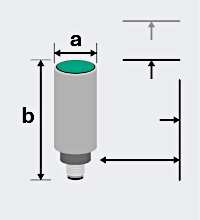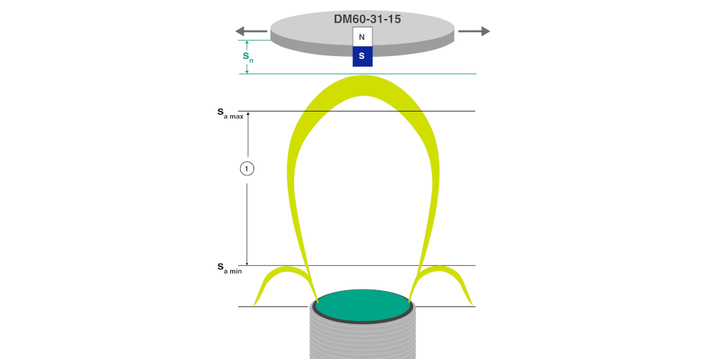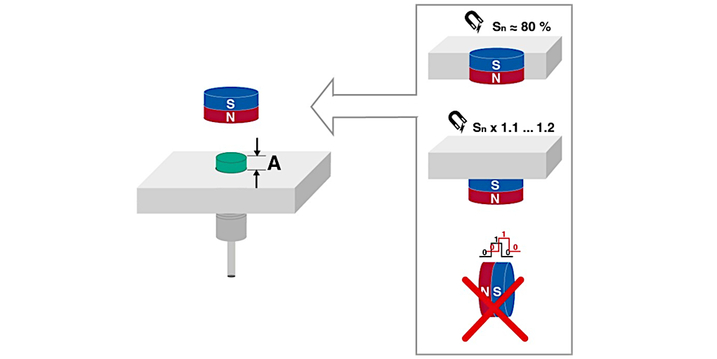Installation Conditions

The installation conditions provide information about optimal installation of the sensors in the application without being restricted in their specified function (i.e., their operating distance). Due to the given installation conditions, a functional range must always be assumed. There is a connection between installation and operating distance.
Cylindrical Magnetic Field Sensors
Cylindrical magnetic field sensors can be flush or nonflush mounted in all non-magnetizable materials and metals without affecting the operating distance.
Minimum Distance between Sensor and Magnet
The operating distance sn depends on the type of damping magnet used. If the magnet has a unipolar alignment (north or south pole of the magnet points toward the sensor), a central sensing range of the sensor occurs with lateral side humps. These side humps are responsible for ensuring that a certain minimum distance between the sensor and the magnet is maintained for clear switching characteristics.

Figure: Sensing range (1) with unipolar orientation of the magnet
Flush Sensor Installation in Non-Magnetizable Material
Sensor, Order Designation |
Operating Distance [mm] with Flush Mounting |
|---|---|
|
MB60-… /MMB60 |
5 … 60 |
|
MMB70-… |
5 … 70 |
|
MB80-… |
20 … 80 |
Arrangement Options for the Damping Magnets

Figure: Flush-mounted sensor with the corresponding mounting options of the damping magnet
Note on the Arrangement Options for the Damping Magnet
In principle, this arrangement combination allows the damping magnet to be inserted flush into a carrier material or attached so that it is nonflush. It does not matter whether the north or south pole of the magnet points toward the sensor. It is important to note:
- Flush mounting: If the damping magnet is installed in a magnetizable carrier material, the operating distance (sn) is reduced significantly to as much as 60 % due to the magnetic short circuit in the carrier material.
- Nonflush mount: If the damping magnet is mounted on a magnetizable carrier material, the operating distance (sn) can increase to 1.1 – 1.2 times the value.
- Magnet alignment: For the magnetic field sensor to function properly, the magnet must be oriented such that either the north or south pole of the magnet points toward the sensor. If the magnet is aligned transversely to the sensor axis, this can result in the output of double switch points.
Nonflush Sensor Installation
Sensor, Order Designation |
Operating Distance [mm] with Nonflush Mount |
|---|---|
|
MB60/MMB60 |
5 … 60 |
|
MB70 |
5 … 70 |
|
MB80 |
20 … 80 |
Arrangement Options for the Damping Magnets

Figure: Nonflush-mounted sensor with the corresponding mounting options of the damping magnet
A: Clearance to keep the interference on the operating distance at ≤ 5 % when installing in magnetizable materials
Sensor, Order Designation |
Clearance A |
|---|---|
|
MB60/MMB60 |
10 mm |
|
MB70 |
15 mm |
|
MB80 |
20 mm |
Note on the Arrangement Options for the Damping Magnet
In principle, this arrangement combination allows the damping magnet to be inserted flush into a carrier material or attached so that it is nonflush. It does not matter whether the north or south pole of the magnet points toward the sensor. It is important to note:
- Flush mounting: If the damping magnet is installed in a magnetizable carrier material, the operating distance (sn) is reduced significantly to as much as 60 % due to the magnetic short circuit in the carrier material.
- Nonflush mount: If the damping magnet is mounted on a magnetizable carrier material, the operating distance (sn) can increase to 1.1 – 1.2 times the value.
- Magnet alignment: For the magnetic field sensor to function properly, the magnet must be oriented such that either the north or south pole of the magnet points toward the sensor. If the magnet is aligned transversely to the sensor axis, this can result in the output of double switch points.
Other Magnetic Field Sensors
Cubic sensors also have installation conditions for flush and nonflush mount. These are specific to the product series and are available as installation information in the technical data for the selected sensor.









 +49 621 776-0
+49 621 776-0